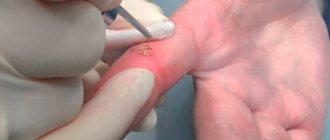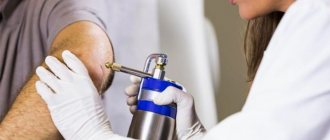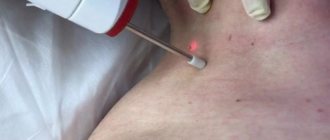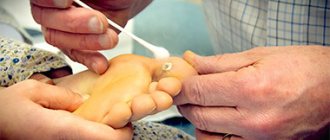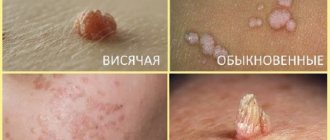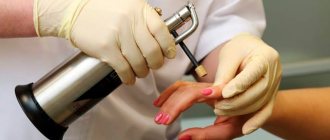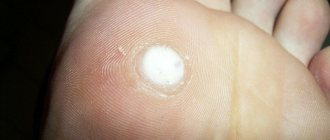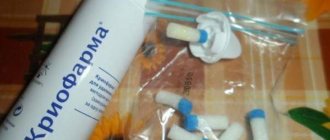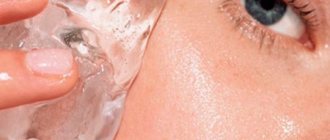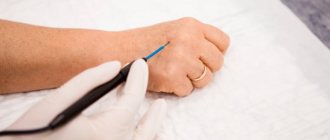Cryodestruction of warts
is a method of combating certain skin tumors using liquid nitrogen. Cryodestruction of warts is performed using two methods.
Using a special device, warts are frozen by pressing the tip of the applicator onto the affected area for 2 minutes. The effect is due to the cooling of the formation at a temperature below 190 degrees.
Removing warts with nitrogen by applying a nitrogen-soaked cotton swab to the wart for about 3 minutes. The duration of the procedure depends on the volume of the growth.
Freezing large warts requires an additional session. A repeated procedure is usually carried out when eliminating plantar growths. This is due to the fact that rough skin on the heels prevents nitrogen from penetrating deeply into the tissue. If wart removal with liquid nitrogen is performed too superficially, the risk of recurrence increases.
After the procedure, the doctor prescribes immunomodulators and vitamin supplements that increase the body's resistance to infections.
Removing warts with liquid nitrogen requires a rehabilitation period, during which certain rules must be followed. After exposure to low temperatures, a slight swelling forms at the site of the growth. Within 24 hours after the procedure, an epidermal blister is formed, filled with serous/hemorrhagic fluid. The bladder cannot be pierced; it must be lubricated with salicylic alcohol twice a day.
It is not recommended to wet the lesion for 3-4 days after the procedure. Usually the bubble decreases within a week and is replaced by a hard crust, which, in turn, begins to gradually peel off. After 2 weeks, a slightly pink spot remains in its place, which disappears over time.
Throughout the entire rehabilitation period, from the blister stage to the formation of the spot, it is prohibited to expose this area to sunlight.
Burning warts with nitrogen activates destructive processes, which is ensured by exposure to low temperatures.
Causes of warts
Prerequisites for the formation of warts:
- neglect of personal hygiene rules (using someone else's shoes, washcloths, towels, manicure and pedicure instruments);
- increased skin moisture, especially hyperhidrosis of the feet and hands;
- immunodeficiency states of the body (HIV infection, cancer, treatment with cytostatics, viral hepatitis B and C);
- chronic stress;
- chronic dermatoses requiring treatment with external hormonal agents (atopic dermatitis, psoriasis, eczema and other itchy dermatoses);
- metabolic disorders in the body and hormonal dysfunctions.
Warts also often appear on thin baby skin.
Types of warts
Depending on the location and appearance, warts can be flat, vulgar and plantar.
Flat warts are often multiple, have the color of the surrounding skin and are small in size (no more than 5 mm), painless, with little or no surface roughness. The most common location of flat warts is the skin of the face.
Vulgar warts are larger (from 2 mm to 10 mm), located singly or in groups, protrude above the surface of the skin, have a pronounced rough surface, the color matches the color of the surrounding skin, sometimes they can have a yellowish, grayish or pink tint. In some cases, “black dots” are visible on the surface of a vulgar wart - this is the result of thrombosis of small capillaries feeding the neoplasm. Vulgar warts can be located in any part of the skin, but more often on the hands.
Plantar warts are localized on the skin of the soles, and due to pressure when walking, they grow inward, causing pain and discomfort. They can reach large sizes (up to 15–20 mm in diameter), the color is often yellowish. The characteristic differences between a plantar wart and a callus of the sole are a violation of the skin pattern of the sole and pain with lateral compression.
There is the ability for warts to resolve on their own as a result of the development of immunity to the human papillomavirus, but this is not so common. If warts last for a long time, they can spread through contact by rubbing the skin, as well as transmitting the virus to family members or organized groups.
The main way to treat warts is removal. Methods such as surgical, radio wave, laser, electrocoagulation, chemical destruction and cryodestruction are used.
Indications
Warts cause a lot of inconvenience, especially if they are located in an area of constant friction. They should be removed if you observe the following signs in the area of the tumor:
- the presence of constant pain;
- burning sensation, itching;
- a sharp increase in size, change in color;
- bleeding;
- purulent discharge;
- increase in the number of warts.
A benign formation of viral etiology against the background of decreased immunity and the addition of a secondary infection can degenerate into malignant!
Benefits of removing warts with nitrogen
Advantages of cryodestruction of warts:
- does not require preliminary anesthesia;
- contraindications are minimal (cold allergy and cryoglobulinemia);
- there is no violation of the integrity of the skin or bleeding, which reduces the risk of secondary infection;
- no scars form after removal;
- The virus is destroyed by exposure to cold.
The main disadvantage of the method is that it does not get rid of tumors immediately, since the process of wart rejection occurs within 2–4 weeks. In some cases, repeated cryodestruction of elements is required.
What is the procedure for removing warts?
Before starting the procedure, the doctor must diagnose the type of wart under a microscope and carry out the necessary allergy tests. Special cryogenic freezing equipment with the required applicator size is used.
Sequence of cryodestruction actions:
- the surface to be treated is cleaned with an antiseptic, then a softening cream is applied to improve the permeability of nitrogen deeper, local anesthesia is prescribed according to indications;
- press the cryoapplicator onto the wart for no more than 120 seconds, spraying liquid at a temperature of -196 ⁰C;
- under the influence of nitrogen, the wart turns pale, becomes denser, then a bubble appears, which lasts up to 7 days (during this period it decreases and becomes covered with a crust);
- the dead area is rejected naturally, and a reddish spot forms in its place. It does not require special treatment; it can be lubricated with regenerating creams.
Stages of cryodestruction of warts
The procedure for removing warts with nitrogen is performed as follows:
- Before starting the procedure, the doctor conducts a survey of the patient to identify predisposing factors and exclude contraindications for cryodestruction.
- Clinical examination of the entire skin and pathological formations. Diagnosis of warts usually does not cause difficulties; in doubtful cases, dermatoscopy can be used - hardware examination of tumors under a magnifying device. Warts have characteristic dermoscopic signs, so dermatoscopy allows you to confirm the diagnosis in doubtful cases.
- The patient takes a comfortable place on the couch and frees access to the tumors from clothing.
- The specialist directly affects the wart tissue with liquid nitrogen. For this purpose, contact and non-contact methods of cryodestruction are used. With the contact method, a cotton swab wound on a stick is moistened with liquid nitrogen and applied to the lesion for a few seconds (from 10 to 60). The patient experiences slight discomfort in the form of a feeling of cooling and some tolerable pain. With the non-contact destruction method, nitrogen is supplied through the apparatus in the form of an aerosol and freezes the lesion “from a distance.” The time of exposure to cold, the cooling area, and the frequency of procedures are determined by a specialist, taking into account the type and size of warts, their location, and the individual characteristics of the skin. Maximum exposure and repetition of the procedure are required mainly when removing plantar warts.
- After the procedure, the patient receives recommendations, and in most cases remains able to work.
Cryopharma for condylomas
There is a commercially available drug for freezing warts at home. It is called Cryopharma, it contains a mixture of propane and dimethyl ether. The temperature of such a substance during processing is only -57C, so the risk to adjacent tissues is minimized. Usually one use is enough to completely remove the formation. Suitable for warts no larger than 7.5 mm. However, before purchasing, you should visit a dermatologist and make sure of the nature of the origin of the tumors.
The packaging of the product is designed so that it is convenient and safe for a person to carry out the procedure. The kit contains an aerosol can, several disposable applicators and one holder. To start using you need:
- Insert the disposable applicator into the holder.
- Connect this structure to the cylinder.
- Press and hold for 3 seconds.
- Apply the applicator with the substance to the problem area and hold for half a minute.
One applicator is used for only one object to be removed. After using the product, you should follow simple recommendations:
- do not pierce or comb the resulting bubble;
- keep the treated area clean;
- if necessary, the cauterization site can be sealed with a plaster;
- taking a shower or other water procedures is not prohibited;
- if the formation causes pain and burning for a long time, you should consult a doctor.
Pharmacy chains also offer Cryopharm for feet; this option is suitable for plantar warts.
Removing genital warts in this way will not lead to any discomfort in a person’s future life . But still, the use of the product has contraindications:
- children under 4 years of age;
- diabetes;
- pregnancy and breastfeeding;
- soreness, redness and inflammation of the skin in the treatment area.
It is not recommended to use on particularly sensitive areas of the body (face, genital area). People with poor circulation should always consult a doctor before use. Cryopharm is not used to remove birthmarks. It is also prohibited to apply the composition to dark moles and formations of unknown origin.
Recently, even in medical institutions they prefer to use a drug of this type to freeze condylomas on the skin of patients. After all, the method of application is simple, and there are practically no risks of complications.
Mechanism of removing warts with nitrogen
The effect of cryodestruction is associated with the physical properties of liquid nitrogen: its boiling point (evaporation) is -196°C. When exposed to a wart, local freezing of the neoplasm structures and subsequent thawing occurs. As a result, thrombosis of the microcapillaries feeding the wart occurs. A few hours after exposure to liquid nitrogen, a bubble forms, the contents of which may be transparent and bloody. After a few days, the bubble shrinks to form a crust, which is subsequently rejected along with the destroyed wart. There may not be any formation of a bubble; darkening of the wart tissue is possible, followed by rejection of the “scab”.
Contraindications
The use of liquid nitrogen is not recommended if the following conditions exist:
- intolerance to cold, manifestation of allergic reactions;
- epileptic seizures;
- predisposition to increased blood pressure;
- a disease accompanied by an inflammatory process;
- irritation, rash, injured skin around the wart;
- pregnancy, lactation period;
How should a patient behave after cryodestruction?
After completing the procedure, it is important:
- when forming a bubble, try not to injure it, do not rub, do not scratch;
- in case of accidental trauma to the bladder, treat the lesion with solutions of aniline dyes (fucorcin, methylene blue) or a strong solution of manganese to prevent secondary infection;
- disinfect household items (washcloths, towels, shoes, manicure and pedicure tools);
- maintain hygiene of clothing and footwear;
- if there is redness, pain, discharge from the lesion, consult a specialist.
Foot care after treatment
Cryotherapy does not affect the general condition and does not cause discomfort, but the location of the warts on the soles of the feet complicates the situation - pain may be felt while walking.
Care instructions:
- on the first day it is allowed to take an anesthetic (Ibuprofen, Nurofen);
- you cannot seal the bubble that appears - there is a possibility of breaking through the membrane and causing an infection;
- it is allowed to apply a gauze napkin, securing it around the edges with a bandage, or bandage it;
- when fluid is released, treatment with an antiseptic (Miramistin, Chlorhexidine) 2 times a day is indicated;
- bathe carefully, trying not to touch the affected surface;
- if the size of the bubble is too large, make a puncture in two places with a sterile needle, carefully squeeze out the liquid contents and glue a sterile napkin.
To ensure quick healing:
- do not use cosmetic creams after removal;
- do not tear off the formed crust;
- Young skin outdoors should be protected from exposure to sunlight.

